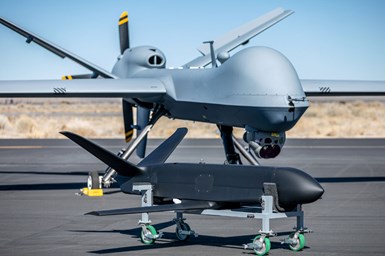GA-ASI Integrates Digital Manufacturing Process for Unmanned Aircraft Systems
GA-ASI is working to apply Divergent’s data-driven approach to design, fabricate and assemble vehicle structures for manufacturing its line of unmanned aircraft systems.
General Atomics Aeronautical Systems (GA-ASI) — a manufacturer of unmanned aircraft systems (UAS), radars, electro-optic and related mission systems — is partnering with Divergent Technologies to support its additive manufacturing (AM) applications development efforts and implement a full digital manufacturing process for GA-ASI’s products.
Divergent has developed a data-driven approach to design, fabricate and assemble vehicle structures called the Divergent Adaptive Production System (DAPS). GA-ASI is working with Divergent to apply this capability to manufacturing its line of UAS.
“Throughout our 30 years of designing and developing advanced UAS, GA-ASI has been focused on implementing new capabilities into our manufacturing process,” says David R. Alexander, GA-ASI President. “We’re working with Divergent to integrate their technology as part of our Additive Design and Manufacturing Center of Excellence strategy, with the goal of optimizing our design and manufacturing processes and providing next-generation UAS at the lowest cost.”
In 2022, GA-ASI began a joint development program with Divergent, which led to a stronger strategic partnership on multiple platforms. GA-ASI’s AM, aircraft integrity, material and design engineering teams are working with Divergent to adapt, apply and qualify its automobile industry-qualified technology to GA-ASI’s aircraft production. Divergent has grown within the automobile sector as a digital manufacturing process innovator, producing some of the fastest cars on the market with several recent car OEM adoption announcements.
“Divergent has invented the first industrial digital manufacturing system. Leveraging innovations in artificial intelligence, 3D printing and automation, DAPS can be used to build the underlying structure for virtually any vehicle — whether land, sea, air or space — better, faster and more cost efficiently than traditional manufacturing,” says Kevin Czinger, Divergent founder, lead inventor and CEO.
GA-ASI and Divergent have already completed two projects leading to a fully integrated small (< 500 lbs) UAS aerostructure, leveraging model-based, artificial intelligence (AI)-driven and topology-optimized designs. The integrated metal structure was 3D printed, which led to the reduction of the part count integration by over 95% while meeting weight targets.
The DAPS process inspected each printed component by creating a full digital twin of the small UAS (SUAS) that was then applied to a fully automated, toolless robotic assembly process that took less than 20 minutes to complete. This process enabled the team to go from a print-ready SUAS design to a fully assembled deliverable airframe in less than two days. GA-ASI anticipates this capability will enable near-theater ramp capacity in the future to support the warfighter.
The company says this innovative approach to design and manufacturing leads to highly integrated weight and performance-optimized designs that are naturally, but not exclusively, leveraging AM technologies at a substantially lower airframe recurring cost, while providing a rapid toolless iterative design approach for multiple platform variants.
- Learn more about General Atomics Aeronautical Systems’s Additive Design, Manufacturing Center which focuses on AM applications, R&D, large-scale tooling and next-generation flight hardware to streamline the manufacturing of unmanned aircraft systems.
Related Content
-
8 Cool Parts From Formnext 2023: The Cool Parts Show #65
New additive manufacturing technologies on display at Formnext were in many cases producing notable end-use components. Here are some of the coolest parts we found at this year’s show.
-
3D Printed "Evolved Structures" for NASA Exoplanet Balloon Mission: The Cool Parts Show #61
Generative design creates stiff, lightweight brackets for EXCITE mission monitoring planets orbiting other stars. The Cool Parts Show visits Goddard Space Flight Center.
-
Beehive Industries Is Going Big on Small-Scale Engines Made Through Additive Manufacturing
Backed by decades of experience in both aviation and additive, the company is now laser-focused on a single goal: developing, proving and scaling production of engines providing 5,000 lbs of thrust or less.















